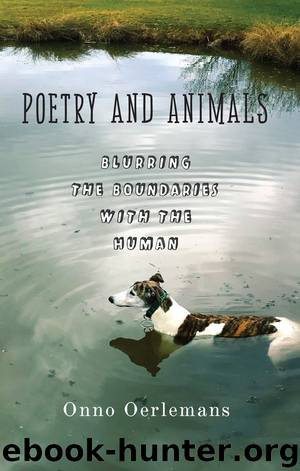Poetry and Animals: Blurring the Boundaries With the Human by Onno Oerlemans

Author:Onno Oerlemans
Language: eng
Format: epub
Tags: Literary Criticism, American, General, European, English; Irish; Scottish; Welsh, Poetry, Nature, Animal Rights, Animals, Social Science, Anthropology, Cultural & Social
Publisher: Columbia University Press
Published: 2018-03-06T00:00:00+00:00
One have I marked, the happiest guest
In all this covert of the blest:
Hail to Thee, far above the rest
In joy of voice and pinion,
Thou, Linnet! In thy green array,
Presiding Spirit here today,
Dost lead the revels of the May;
And this is thy Dominion.17
Though the poem also does the work of identifying the species, as I demonstrated in the previous chapter, it is worth noting that virtually every conscious act of the speaker involves singling out what to see. He defines the behavior of the bird itself as singular, refusing to merge with the rest of the scene, and thus “sole in thy employment.” This emphasis on singularity and immediacy is more striking when one realizes that most other poems about animals in the romantic period feature the animal as a symbolic part of a narrative, or as is largely the case with John Clare’s poems, attempt to define the animal as a species, based on a recollection of many encounters.
It seems clear to me that Wordsworth is genuinely interested in animals as instances of consciousness other than his own, even when he also uses them as symbols for aspects of nature. Consciousness inheres in the idea of the individual. More influential examples of this early mode of the genre are John Keats’s “Ode to a Nightingale” and Percy Bysshe Shelley’s “To a Skylark.” Both are undoubtedly inspired by actual encounters with real birds, are addressed to single birds, and reflect the fact that many birds (especially the small reclusive songbirds these poets write about) are mostly heard rather than seen. I think David Perkins is right that though the birds of these central romantic poems are not necessarily humanized, the poems nonetheless “transform natural behavior of the birds into metaphors of human desires,”18 though resisting this tendency can only ever be a matter of degree. The actual encounter is overweighed by the requirements of high literary art, so that the poems ultimately reflect more about the poet and his imagination than the being that inspired it. It is as though the poets are still too encumbered by literary and cultural conventions about the animal, or even by embarrassment, to allow the animal to be the poem’s central topic.
I have been arguing that we can find in the romantic period the origins of the lyric of animal encounter. I have also suggested that it evolves into a form that ultimately allows the animal a more central place in the poem and in our culture. An old-fashioned historicist genealogy of the genre would explore who among later poets read Wordsworth’s encounter lyrics, including the ones on animals, and took them as a serious model for their own work. I suspect later works are a refashioning or evolution of the models created by Wordsworth and Keats, produced not simply by a literary desire to imitate previous authors and genres but by the desire to represent meaningful experience with a literary form suited to express the meaning of that experience. The romantic lyric allows for
Download
This site does not store any files on its server. We only index and link to content provided by other sites. Please contact the content providers to delete copyright contents if any and email us, we'll remove relevant links or contents immediately.
| Ancient & Classical | Arthurian Romance |
| Beat Generation | Feminist |
| Gothic & Romantic | LGBT |
| Medieval | Modern |
| Modernism | Postmodernism |
| Renaissance | Shakespeare |
| Surrealism | Victorian |
4 3 2 1: A Novel by Paul Auster(12329)
The handmaid's tale by Margaret Atwood(7705)
Giovanni's Room by James Baldwin(7250)
Asking the Right Questions: A Guide to Critical Thinking by M. Neil Browne & Stuart M. Keeley(5708)
Big Magic: Creative Living Beyond Fear by Elizabeth Gilbert(5676)
Ego Is the Enemy by Ryan Holiday(5347)
The Body: A Guide for Occupants by Bill Bryson(5027)
On Writing A Memoir of the Craft by Stephen King(4892)
Ken Follett - World without end by Ken Follett(4682)
Adulting by Kelly Williams Brown(4530)
Bluets by Maggie Nelson(4510)
Eat That Frog! by Brian Tracy(4483)
Guilty Pleasures by Laurell K Hamilton(4392)
The Poetry of Pablo Neruda by Pablo Neruda(4063)
Alive: The Story of the Andes Survivors by Piers Paul Read(3996)
White Noise - A Novel by Don DeLillo(3980)
Fingerprints of the Gods by Graham Hancock(3964)
The Book of Joy by Dalai Lama(3944)
The Bookshop by Penelope Fitzgerald(3810)
